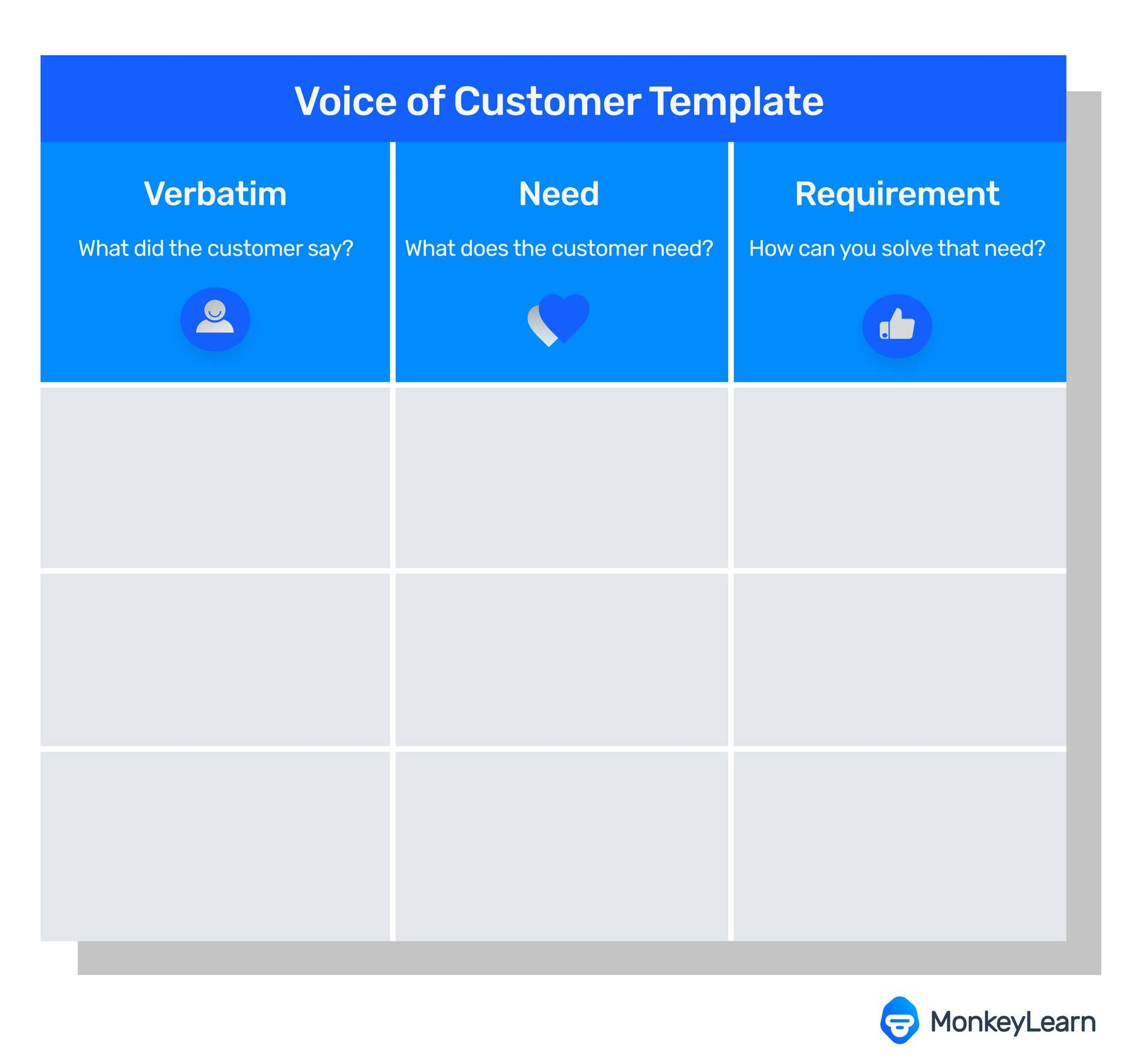Voice of Customer Template & Tips

Understanding what drives your customers, how they use your products or services, and what they expect from your company, overall, are crucial to the success of any business. From performing a customer needs analysis to setting up a customer feedback loop, the needs of your customers should be at the center of everything you do.
There are a number of analysis techniques you can focus on, but one of the most important is all about the voice of the customer (VoC). Read on to learn about VoC analysis and how to make your own voice of customer template.
- What is Voice of the Customer (Voc)
- How to Create a VoC Program
- Voice of Customer Template
- Voice of Customer Best Practices
What Is Voice of the Customer (VoC)?
Voice of the customer (“voice of customer”) is a method for describing and understanding how customers talk about and feel about a brand and its products or services. The “customer's voice” or “buyer persona” is any kind of customer feedback from product reviews, social media comments, customer service interactions, survey responses, and more.
Voice of customer is important to understand both how brands excel for their customers, and where they may be lacking, in order to improve products and services, decrease customer churn, and increase profits. Adding a voice of customer template to your analytical tools will make sure you consistently cover the necessary questions you need answers for and potential issues your customers may be facing.
VoC analysis aims to get inside the heads of your existing customers, so you can find out how to best serve them, and how to draw in new customers. What do people love about your company and what are particular customer pain points in the customer experience (CX) and product experience (PX)? Digging into customer pain points can be huge to increase retention and keep you customers happy.
How to Create a VoC Program
Once you set up your VoC analysis process, you’ll get regular, 24/7 customer insights to help make real-time, data-driven decisions to improve the customer experience.
Set up your VoC program in just three steps:
1. Collect VoC data
You have a lot of solid options for good data on your customers:
NPS and CSAT Surveys
Net Promoter Score (NPS) and Customer Satisfaction (CSAT) surveys are effective and efficient ways to get into the minds of your customers. You can create questions for exactly the information you need and send them at different points of the customer journey – like just after purchase and just after onboarding – to pinpoint pain points and find out what aspects of your company or products may be less than impressive to potential and existing customers.
Basic NPS and CSAT surveys ask close-ended questions with simple, limited responses that usually range from Yes/No to True/False to rated on a scale from 1 to 10, and so on. They uncover quantifiable data that’s easy to calculate and gives you a good understanding of what has happened.
You can dive deeper, however, with open-ended questions, to get to the opinions and feelings of your customers, to find out why something did happen. Regardless of your course of action, online survey tools, like SurveyMonkey and Typeform make gathering VoC data easy, and integrate easily with data analysis tools.
Social Media
Social listening techniques are perfect for understanding what customers are saying about your brand and products all over social media. Furthermore, unsolicited customer feedback from social media, forums, etc., is often the most useful because customers are more likely to be honest with completely spontaneous feedback.
If you know just a bit of code (or are willing to follow a quick tutorial), most social media sites, like Twitter and Facebook offer APIs to connect directly to their data.
Product Reviews
Similar to social media feedback, product reviews can offer unrestrained and unsolicited customer viewpoints for data full of opinions and feelings that are particularly helpful for VoC analysis. Web scraping tools make it easy to extract data from product review sites and all over the web. Furthermore, customers usually have to go out of their way to leave a review online, so it generally means they have strong opinions that can provide useful insights.
Customer Support Data
You’re probably already collecting a lot of useful VoC data from CRM systems, customer support tools, emails, live chats, and more. The great thing about integrating VoC analysis tools into your customer service processes is that, not only will you extract a lot of extremely useful data, but you can pretty quickly build a full-blown ticket management system to funnel all of your customer support to one place and streamline processes.
Website Behavior
Website tracking tools and e-commerce applications allow you to follow customer behavior and save data for future analysis. Website behavioral analysis often provides more quantitative than qualitative results. However, when you join website and purchasing behavior data, with customer support data and other insights, you can build truly remarkable personalized marketing campaigns.
2. Analyze your data
Now it’s time to dive into your data. The process of creating a VoC system is much simpler these days with easy-to-use and easily accessible machine learning AI tools. Tedious, time-consuming, and sub-par human analysis is a thing of the past.
SaaS text analysis platforms, like MonkeyLearn, can be a huge help to gather and analyze your data. You can use pre-trained tools or custom train your own to the language and needs of your business. Take this tweet, for example:

MonkeyLearn’s pre-trained sentiment analyzer automatically reads it as negative:
Other text analysis tools, like topic analysis, keyword extraction, and aspect-based sentiment analysis can get even more insights from your VoC data, to really get into the heads of your customers.
MonkeyLearn integrates with tools you already use, like Excel, Google, Zendesk, SurveyMonkey, and more to simplify the VoC analysis process and set you up for success, so you don’t have to waste time (and get less accurate results) with manual analysis.
3. Take action
Now you have your results, and it’s time to follow the voice of the customer to improve your products and services and make them happier, overall. Once it’s set up, VoC analysis works 24/7 and in real time, so you can react quickly to new issues and follow customer sentiment as it rises and falls.
And, finally, let your customers know that you’ve heard them. Always be sure to close the feedback loop by informing your customers that you’ve listened to their advice and instituted any relevant changes.
Voice of Customer Template
A voice of customer template is an outline or checklist for VoC-related questions to ask your customers. A VoC template will help set goals for how to analyze VoC data and make sure you’re always gathering the right data and asking the right questions.
There are many voice of customer template examples, including this one below, which is free for you to download.
Voice of Customer Best Practices
Take a look at some voice of customer examples and tips to perform voice of customer analysis.
First of all, make sure you’re gathering good customer data from as many (good) sources as possible. Integrating customer support tools, like Zendesk, Freshdesk, Service Cloud, HelpScout, etc. for an omnichannel support center is a good start. It will streamline customer service interactions to proactively avoid customer pain points and collect data for analysis.
Integrated support tools and internal CRM systems can also ensure that VoC data is shared across your organization, from department to department, and employee to employee. Support integration ensures that your customer service staff stays on top of issues and “closes the loop” on customer feedback to let customers know that their complaints, issues, or feedback have been dealt with.
Always be aware of the entire customer journey, and decide on best practices for asking and the best times to request customer feedback. This may be one of the most important aspects to build into your voice of customer template. What are your company’s major customer journey touchstones? Product awareness? Sales? Onboarding? Features?
And don’t forget about service cancelation/non-renewal or switching to the competition’s products. Sometimes the most negative VoC data can have the most positive effects. Voice of customer methodologies will differ depending on your business, but one thing is sure – AI machine learning can help get the most from your customer data.
The Takeaway
VoC is a powerful tool for understanding your customers, improving your products and services, and, ultimately, increasing your profits. You can make the process easier with a VoC template to ensure that you’re always asking the right questions and seeking the information you need. Add machine learning AI tools to the mix, and you’ll have VoC analysis tackled in no time.
Take a look at all the powerful text analysis tools MonkeyLearn has to offer to see how your voice of customer template can be taken care of from start to finish.

Rachel Wolff
March 5th, 2021







